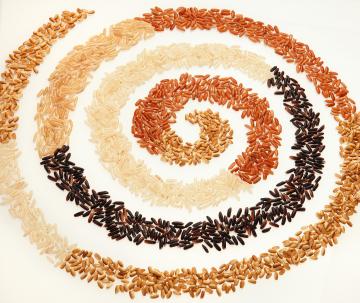Making Rice Even Nicer

Rice grains with different colors of bran: white, light brown, brown, red, and purple. (Peggy Greb, D2846-6)
Rice is a dietary staple for more than half of the world’s population. In the United States, we consumed about 4.28 million metric tons of rice in 2017-2018. That’s around 26 pounds per person per year!
Whole-grain rice has advantages over milled rice because the bran, or outer layer, of the grain remains intact. Rice bran contains nutrients, minerals, and bioactive compounds like tocopherols, tocotrienols, and γ-oryzanol. Rice with purple or red bran has anthocyanins and proanthocyanidins, respectively. Eating whole-grain rice is associated with a reduction in risk factors for cardiovascular diseases and some types of cancers.
But the bran is just a very thin coating over the much larger rice grain. An Agricultural Research Service (ARS) research team in Stuttgart, Arkansas, thinks that increasing the proportion of bran to grain will enhance whole grain rice’s overall nutritional value.
The team studied 134 diverse rice cultivars from ARS’s vast rice collection, curated at the Dale Bumpers National Rice Research Center in Stuttgart. They found that different cultivars naturally had heavier bran layers than others—some up to 2.5 times as heavy. Purple bran types had the heaviest bran, followed by red, white, light brown, and brown. With this knowledge, rice breeders can improve whole grain nutritional quality by selecting these types for their breeding programs.
The bran layer has a slight down side, too: Although bran contains most of the rice grain’s fats (lipids), which can be extracted for use in cooking oils, it also contains enzymes (lipase and lipoxygenase) that break down those fats. That action shortens the rice’s shelf life and can lead to rancidity.
The Stuttgart team evaluated a set of diverse rice varieties with different bran colors and found more than a 15-fold variation in rancidity levels. Red, purple, and brown brans had lower rancidity levels than the light-brown and white brans. Within the light-brown brans typical of U.S. cultivars, the team found varieties that had less enzyme activity and could be used in breeding to improve storage stability of U.S. brown rice.
Arkansas is the nation’s chief rice-growing state, with a crop value of $1.16 billion in 2018.—By Sue Kendall, ARS Office of Communications.
You May Also Like:

